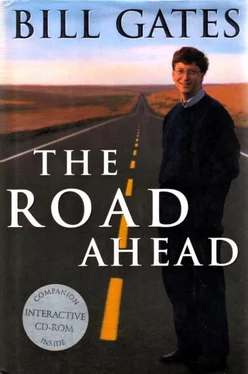Before the 360, computer designs were intentionally incompatible with those from other companies because the manufacturer’s goal was to make it discouragingly difficult and expensive for customers heavily invested in one company’s computer to switch to a different brand. Once a customer committed to a machine, he or she was stuck with offerings from the computer’s manufacturer because changing the software could be done but was too difficult. Amdahl and the others ended that. Market-driven compatibility is an important lesson for the future personal-computer industry. It should also be remembered by those creating the highway. Customers choose systems that give them a choice of hardware suppliers and the widest variety of software applications.
While this was going on, I was busy enjoying school and experimenting with computers. I arrived at Harvard in the fall of 1973. In college there is a lot of posturing, and appearing to slack off was considered a great way to establish your coolness. Therefore, during my freshman year I instituted a deliberate policy of skipping most classes and then studying feverishly at the end of the term. It became a game—a not uncommon one—to see how high a grade I could pull while investing the least time possible. I filled in my leisure hours with a good deal of poker, which had its own attraction for me. In poker, a player collects different shards of information—who’s betting boldly, what cards are showing, what’s this guy’s pattern of betting and bluffing—and then crunches all that information together to devise a plan for his own hand. I got pretty good at this kind of information processing.
The experience of poker strategizing—and the money—were helpful when I got into business, but the other game I was playing, the postponing one, didn’t serve me well at all. But I didn’t know that then. In fact, I was encouraged that my dilatory practices were shared by a new friend, Steve Ballmer, a math major whom I met freshman year, when we lived in the same student dorm, Currier House. Steve and I led very different lives, but we were both trying to pare down to the minimum the course time needed to get top grades. Steve is a man of endless energy, effortlessly social. His activities took a lot of his time. By his sophomore year he was a manager of the football team, the advertising manager for the Harvard Crimson , the school newspaper, and president of a literary magazine. He also belonged to a social club, the Harvard equivalent of a fraternity.
He and I would pay very little attention to our classes and then furiously inhale the key books just before an exam. Once we took a tough graduate-level economics course together—Economics 2010. The professor allowed you to bet your whole grade on the final if you chose. So Steve and I focused on other areas all semester, and did absolutely nothing for the course until the week before the last exam. Then we studied like mad and ended up getting A’s.
After Paul Allen and I started Microsoft, however, I found out that that sort of procrastination hadn’t been the best preparation for running a company. Among Microsoft’s first customers were companies in Japan so methodical that the minute we got behind schedule they would fly someone over to baby-sit us. They knew their man couldn’t really help, but he stayed in our office eighteen hours a day just to show us how much they cared. These guys were serious! They would ask, “Why did the schedule change? We need a reason. And we’re going to change the thing that caused it to happen.” I can still feel how painful being late on some of those projects got to be. We improved and mended our ways. We’re still late with projects sometimes but a lot less often than we would have been if we hadn’t had those scary baby-sitters.
Microsoft started out in Albuquerque, New Mexico, in 1975 because that’s where MITS was located. MITS was the tiny company whose Altair 8800 personal-computer kit had been on the cover of Popular Electronics . We worked with it because it had been the first company to sell an inexpensive personal computer to the general public. By 1977, Apple, Commodore, and Radio Shack had also entered the business. We provided BASIC for most of the early personal computers. This was the crucial software ingredient at that time, because users wrote their own applications in BASIC rather than buying packaged applications.
In the early days, selling BASIC was one of my many jobs. For the first three years, most of the other professionals at Microsoft focused solely on technical work, and I did most of the sales, finance, and marketing, as well as writing code. I was barely out of my teens, and selling intimidated me. Microsoft’s strategy was to get computer companies such as Radio Shack to buy licenses to include our software with the personal computers they sold (the Radio Shack TRS-80, for example) and pay us a royalty. One reason we took that approach was software piracy.
In the early years of selling Altair BASIC, our sales had been far lower than the widespread usage of our software suggested they should be. I wrote a widely disseminated “Open Letter to Hobbyists” asking the early users of personal computers to stop stealing our software so that we could make money that would let us build more software. “Nothing would please me more than being able to hire ten programmers and deluge the hobby market with good software,” I wrote. But my argument didn’t convince many hobbyists to pay for our work; they seemed to like it and used it, but preferred to “borrow” it from each other.
Fortunately, today most users understand that software is protected by copyright. Software piracy is still a major issue in trade relations because some countries still don’t have—or don’t enforce—copyright laws. The United States insists that other governments do more to enforce copyright laws for books, movies, CDs, and software. We will have to be extremely careful to make sure the upcoming highway doesn’t become a pirate’s paradise.
Although we were very successful selling to U.S. hardware companies, by 1979 almost half of our business was coming from Japan, thanks to an amazing guy named Kazuhiko (Kay) Nishi. Kay telephoned me in 1978 and introduced himself in English. He had read about Microsoft and thought he should be doing business with us. As it happened, Kay and I had a lot in common. We were the same age, and he too was a college student on leave because of his passion for personal computers.
We met some months later at a convention in Anaheim, California, and he flew back with me to Albuquerque, where we signed a page-and-a-half contract that gave him exclusive distribution rights for Microsoft BASIC in East Asia. There were no attorneys involved, just Kay and me, kindred spirits. We did more than $150 million of business under that contract—more than ten times greater than we had expected.
Kay moved fluidly between the business cultures of Japan and those of the United States. He was flamboyant, which worked in our favor in Japan, because it bolstered the impression among Japanese businessmen that we were whiz kids. When I was in Japan we’d stay in the same hotel room and he’d be getting phone calls all night long booking millions of dollars of business. It was amazing. One time there were no calls between three and five in the morning, and so when a call came in at five o’clock, Kay reached for the phone and said, “Business is a little slow tonight.” It was quite a ride.
For the next eight years, Kay seized every opportunity. Once, in 1981, on a flight from Seattle to Tokyo, Kay found himself sitting next to Kazuo Inamori, the president of the giant $650 million Kyocera Corporation. Kay, who ran ASCII, his Japanese company, confident of Microsoft’s cooperation, successfully pitched Inamori on a new idea—a small laptop computer with simple software built in. Kay and I designed the machine. Microsoft was still small enough that I could play a personal role in the software development. In the United States, it was marketed by Radio Shack in 1983 as the Model 100 for as little as $799. It was also sold in Japan as the NEC PC-8200 and in Europe as the Olivetti M-10. Thanks to Kay’s enthusiasm, it was the first popular laptop, a favorite of journalists for years.
Читать дальше











